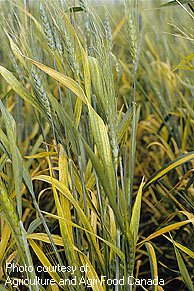Wheat Streak Mosaic
Infected wheat plants may die, fail to set seed, be stunted or be unaffected, depending on when they are infected. Damage usually ranges from noticeable yield reductions to crop failures.

Host Crops
Wheat streak mosaic virus attacks barley, corn and some grasses, but is most common on winter and spring wheat. Oats and rye may be infected but they do not appear to be seriously damaged. Wheat is the only cereal that is seriously affected.
Biology
Wheat streak mosaic is a viral disease of wheat. The virus enters the leaves and spreads to all parts of the plant. Infected plants are usually stunted and produce fewer seeds, which are often badly shrivelled. The earlier the infection, the greater the effect on the plant.
Wheat streak mosaic virus is transmitted by the wheat curl mite and by leaf rubbing. The mite can be blown from field to field by wind.
The mite and virus overwinter on winter wheat. In the spring, mites multiply rapidly and are blown to spring wheat or volunteer spring wheat. These hosts harbour the mite and virus over the summer. If winter wheat is sown near unharvested spring wheat, infected mites can be blown onto winter wheat completing the disease cycle.
Development of this disease depends on the population of mites, the presence of virus-infected wheat plants, and sufficient moisture for good plant growth and rapid mite reproduction. Severe outbreaks occur when there is a build-up of mites and virus on volunteer spring wheat in fields next to winter wheat that was planted early.
Symptoms of the disease become more pronounced when temperatures climb above 10 degrees C (50 degrees F) in the spring.
Symptoms Of Damage
Winter wheat rarely shows symptoms until spring. These symptoms appear on the leaves as dashes, streaks or yellow stripes parallel to the veins. Leaves become increasingly mottled until the green areas disappear and the leaves die. Infected plants are stunted; the degree of stunting depends on how early the infection took place. Wheat spot mosaic virus, which is similar to wheat streak mosaic virus, is spread by mites, has a comparable life cycle, and may sometimes be present in winter wheat.
Wheat infected at an early tillering stage stops growing and produces few to no heads. Infection at late tillering to early jointing stages results in head formation but the flowers may be sterile. With late season infection during jointing to boot stage, the flowers are fertile but kernels are reduced in size. Fall-infected winter wheat plants do not produce grain the following season. One study found that stunted and diseased plants yielded 78% less than healthy plants, and seed milling quality was reduced substantially.
Scouting Techniques
Mites in large populations on wheat will cause the leaf blades to curl upward and inward. Tips of new leaves are often caught in the curled leaf above it; this may indicate the presence of the mites and virus. A microscope or a good magnifying glass is necessary to see the mites.
Economic Thresholds
None available.
Control Tips
- This disease can be controlled or reduced to a minimum by following certain cultural and agronomic practices. The key control method is to disrupt the life cycle of the wheat curl mite by preventing infection of winter wheat. Mites that survive the winter on winter wheat increase rapidly during the warm spring and summer weather and are blown to nearby hosts.
- Do not sow winter wheat near immature spring wheat or other cereals. Seed winter wheat after spring crops are mature. Control all volunteer host plants at least 2 weeks before winter wheat is planted including adjacent fields. The mites cannot survive longer than 10 days in the absence of living cereal plants. Plant winter wheat as late in August or September as possible to avoid the period when mites move from late-maturing spring cereals.
- Do not reseed a severely diseased winter wheat field with spring wheat. Diseased winter wheat plants are difficult to eliminate completely.
- There are no pesticides available for the control of the mite or virus.
For further information, contact your GO representative.
